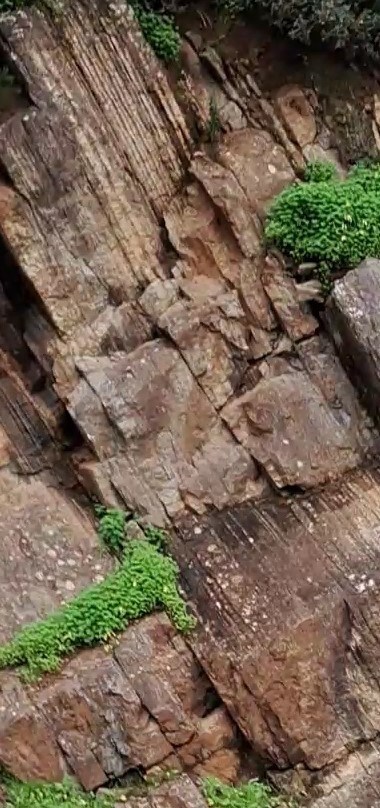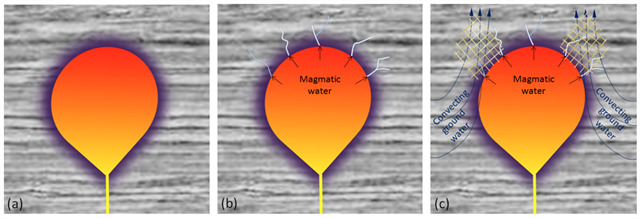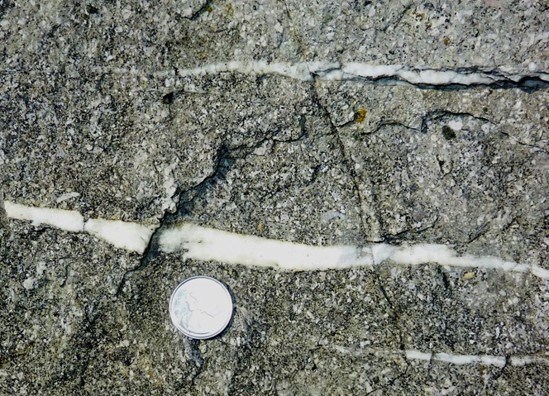O local de observação em concreto é a sensivelmente 1,5 mts de altura e a 1,5mts à direita do poste assinalado na coordenada. Nesse vértice de interseção destas duas retas imaginárias, podes observar um pedaço de rocha recentemente quebrado e ainda fresco com cerca de 60 x 40 cm (foto spoiler disponível se necessitares). Observa com atenção esse segmento e procura responder às 3 questões colocadas via mail do meu perfil. Por favor posta no teu log uma foto que dê conta, de forma inequívoca, da tua presença no local para que o mesmo seja válido:
1. Admitindo que as bandas esbranquiçadas são manifestações metassomáticas calco-silicificadas, como se manifestam aqui? A) Muito intensas! manifestam-se de forma planar e entrecruzada. B) Muito intensas! acompanham a xistosidade e manifestam-se de forma planar. C) Moderadamente intensas! embora se manifestem de forma planar e entrecruzada.
2. Xistosidade refere-se aos planos de foliação de camadas sobrepostas que fazem lembrar as páginas de um livro fechado. Olhando apenas para os veios que se destacam neste pequeno trecho de rocha, quantos planos de foliação destacas?
3. Completa a afirmação com os termos adequados retirados da listing: Os três agentes de metamorfismo são: pressão litoestática ou metamorfismo regional, temperatura ou metamorfismo de contacto e ___________________ ou _________________.
A EARTHCACHE situa-se num local listado como tendo interesse geológico nos limites da intrusão ígnea do maciço da serra de Sintra com os estratos sedimentares que sofreram intenso metamorfismo, mas que se mantém como um refinado testemunho estratigráfico da transição do Jurássico superior para o Cretácico inferior nesta região central da bacia lusitânica. Nesta sucessão de corneanas metamorfizadas visíveis no corte nascente da estrada Aldeia do Juzo/Malveira, são identificáveis os principais grupos sedimentares deformados pelo complexo ígneo constituídos, da base para o topo, pelos Calcários de São Pedro, (Jurássico Superior/Oxfordiano,~163Ma), os Xistos do Ramalhão (Jurássico superior/Oxfordiano/Kimeridgiano (~157/152Ma) e os Calcários de Mem Martins (Jurássico superior/Titoniano - Cretácico Superior/Valanginiano (~145-132Ma)
Pese embora cada um destes grupos sedimentares, de per si, encerre uma história geológica própria, esta Earthcache detém-se apenas nos designados Xistos do Ramalhão.
ENQUADRAMENTO GEOLÓGICO LOCAL:
O Maciço Eruptivo de Sintra (M.E.S.) constitui um diapiro alongado com direção E - W cuja instalação, há cerca de 80Ma, provocou uma acentuada deformação nas rochas encaixantes. Nessa deformação intervieram todos os agentes metamórficos que, em função da proximidade do perímetro ígneo, se manifestaram por pressão litostática associado à intrusão forçada do corpo ígneo que "empurrou" e pressionou os sedimentos em sentido ascendente (Metamorfismo regional), por temperatura, ou contraste de temperatura entre a rocha intrusiva e a encaixante (Metamorfismo de contacto) e por hidrotemalismo devido a fluxos de soluções aquosas aquecidas (Metassomatismo). Em função da exposição a cada um destes agentes metamórficos, isolados ou combinados, as rochas previamente existentes reconfiguraram-se do ponto de vista químico, mineralógico e textural.
Uma das consequências desse metamorfismo foi a geração de Xistosidade com a organização dos sedimentos metamorfizados em bancadas planares que se apresentam agora inclinadas ou sub-paralelas à intrusão. Outras formações foram particularmente afetadas por um forte metassomatismo, sobretudo as formações que se encontravam em ambiente marinho, ou seja, submersas. Nessas áreas ter-se-á registado um intenso fluxo termal que gerou fortes alterações na rocha hospedeira. É neste cenário que se enquadra a formação designada por Xistos do Ramalhão. A este propósito, diz-nos Kullberg que “o contacto do Maciço Eruptivo de Sintra faz-se em grande extensão, a SuI e a Leste, com estreita faixa, descontínua, de calcários muito recristalizados, do Oxfordiano superior, os Calcários de S. Pedro. Noutras zonas, o mesmo contacto suI e leste faz-se com a formação imediatamente suprajacente, os Xistos do Ramalhão, de idade Oxfordiano superior Kimmeridgiano inferior a médio” (Kullberg, pág. 220). Prossegue referindo que um “... fenómeno muito evidente no campo, pela extensão em que ocorre, é o das manifestações metassomáticas associadas à transferência de elementos de e para o maciço, na vizinhança do contacto. Esta auréola metassomática inclui a auréola térmica de metamorfismo de contacto, caracterizada pela formação de corneanas calcos-silicatadas. (…) Os Xistos do Ramalhão devem o seu nome à existência de um bandado metassomático que se desenvolveu preferencialmente em níveis que apresentam favorabilidade geoquímica e que ocupam um sistema de fendas." (Kullberg, pág. 221)
Uma mesma constatação de uma outra publicação refere a propósito desta formação que se trata de "(...) sequências muito espessas, de fácies marinha, de bancos finos de calcários compactos, de cor escura, por vezes margosos, com algumas passagens bioclásticas e margas, silicificadas e “xistificadas”, interestratificados com níveis de brechas calcárias, cada vez mais numerosos e mais espessos para o topo da série. (...) Esta Formação está fortemente afetada por silicificações metassomáticas que lhe conferem aspeto típico de bandas esbranquiçadas, alongadas e entrecruzadas." (Kullberg et al, pag 235)

Esboço estrutural das formações encaixantes do maciço de Sintra (Kullberg) com destaque para as camadas sedimentares do Jurássico Superior e cretácico inferior
Conceitos gerais - XISTOSIDADE E METASSOMATISMO:
Xistosidade refere-se aos planos de foliação (aspeto das camadas em sucessivas finas bancadas que se assemelham a folhas de um livro). Ocorre na estratificação em uma rocha cristalina de granulação grossa devido ao arranjo paralelo de grãos minerais, como moscovita, biotita, quartzo e feldspato. Tratam-se de estruturas penetrativas de minerais recristalizados segundo orientação preferencial em planos e/ou linhas (xistosidade planar e/ou linear).

Aspeto geral de um afloramento xistoso com a sua particular foliação e alinhamento das camadas em finos planos paralelos.
Metassomatismo refere-se ao processo por meio do qual uma rocha pré-existente seja ígnea, sedimentar ou metamórfica sofre alterações na sua composição e mineralogia. Estas alterações estão associadas a reações químicas desencadeadas pelo contacto com fluidos (agentes metassomáticos), que invadem o protólito (ou seja, a rocha a partir da qual ocorreu a formação de uma nova rocha). Numa macro escala, este processo ocorre em zonas de subducção. Nestas zonas a formação de fontes hidrotermais na crosta oceânica e nos bordos superiores do manto desencadeia o movimento de fluidos convexos causando metassomatismo nos bordos da camada superior da zona de subducção.
Numa escala bem menor, também ocorrem importantes fenómenos de metassomatismo quando o hidrotermalismo ocorre nas auréolas de metamorfismo que envolvem a intrusão de um plutão granítico. É este o cenário neste local! Neste caso o corpo ígneo aquecido funciona como um esquentador que aquece os fluidos (normalmente água) existente no magma, causando a sua ascensão ou circulação hidrotermal e o seu alojamento nas fragilidades da rocha instruída. Esta água libertada pelo magma bastante rica em minerais dissolvidos, à medida que arrefece, interage com a rocha já existente alterando a sua composição. Esta alteração que ocorre ora por pressurização, ou pela precipitação gerada pela natural convecção da água aquecida que, à medida que arrefece se afunda, precipita, carregando consigo todo o caldo de minerais dissolvidos e que acabam por preencher as fissuras (fragilidades) da rocha encaixante, tanto pode alterar os feldspatos que se meteorizam em argilas, como pode ocorrer com o preenchimento dessas fissuras com Quartzo, mas também Pirite, Hematite, Calcite e até Prata e Ouro.
O metassomatismo associado ao hidrotermalismo devido à intrusão de corpos graníticos em rochas carbonatadas como os calcários, como é o caso neste local em concreto, produz grandes alterações pela injeção ou deposição de quartzo, sílica, cálcio, magnésio, ferro e outros elementos que acabam por se rearranjar em minerais que normalmente não existem nem na rocha intrusiva, nem na rocha encaixante.
Img1:

Img2:

Img1: Grafismo mostrando as frases de transição metassomática: a) metassotismo termal apenas, b) metassomatismo termal e formação de veios, c) metassomatismo termal, formação de veios em malha e convecção de fluidos / Img2: Aspecto de rocha metassomizada com o característico bandado silicificado
Fontes:
- Geologia de Portugal, Volume II, III.3. A Bacia Lusitaniana: Estratigrafia, Paleogeografia e Tectónica,J. C. Kullberg, R. B. Rocha, A. F. Soares, J. Rey, P. Terrinha, A. C. Azerêdo,P. Callapez, L. V. Duarte, M. C. Kullberg, L. Martins, R. Miranda, C. Alves,J. Mata, J. Madeira, O. Mateus, M. Moreira e C. R. Nogueira, 2013 (https://docentes.fct.unl.pt)
- Controle Estrutural na Instalação do Maciço de Sintra (abstract), M. C. Kullberg
- Thermodynamic and Transport Properties of Silicate Melts and MagmaCharles E. Lesher, Frank J. Spera, in The Encyclopedia of Volcanoes (Second Edition), 2015 (https://magma.geol.ucsb.edu/papers/)
- Physical Geology, First University of Saskatchewan Edition, Adapted from Physical Geology written by Steven Earle for the BCcampus Open Textbook Project, Chaptet 10, 10.6 Metamorphic Hydrothermal Processes and Metasomatism (https://csmgeo.csm.jmu.edu/Floiated Textures of Metamorphic Rock)
/p> 
The exact location for your observations is approximately 2 meters high and 2 meters to the right of the electric pole marked in the coordinate. At the intersection vertex of these two imaginary lines, you can see a piece of rock recently broken and still fresh with about 50 x 30 cm (spoiler photo available!). Observe this segment carefully and try to answer the 3 questions asked via email of my profile. For a complete and valid logging task you ought to post a photo in your log that unmistakably shows your presence at the site.
1. Assuming that the whitish bands are calc-silicified metasomatic manifestations, how do they occur here? A) Very intense! Occur in a planar and crisscrossed geometry. B) Very intense! They follow the schistosity and occur in a planar geometry. C) Moderately intense! although they occur in a flat and crisscrossed geometry.
2. Schistosity refers to the foliation planes of overlapping layers that resemble the pages of a closed book. Looking only at the veins that stand out in this small stretch of rock, how many planes of foliation do you highlight?
3. Complete the statement with the appropriate terms taken from the listing: The three agents of metamorphism are: lithostatic pressure or regional metamorphism, temperature or contact metamorphism, and ___________________ or _________________.
The EARTHCACHE is in a place listed as having geological interest and on the limits of the igneous intrusion of the Sintra mountain massif with the sedimentary strata that underwent intense metamorphism, but which remains as a refined stratigraphic testimony of the Upper Jurassic transition for the lower Cretaceous in this central region of the Lusitanian basin. In this succession of metamorphosed strata visible in the east section of the Aldeia do Juzo/Malveira road, you may see the main sedimentary groups deformed by the igneous complex: From the base to the top they form the Limestones of São Pedro, (Upper Jurassic/Oxfordian, ~163Ma), the Ramalhão Shales (Upper Jurassic/Oxfordian/Kimmeridgian (~157/152Ma) and the Mem Martins Limestones (Upper Jurassic/Tithonian - Upper Cretaceous/Valanginian (~145-132Ma)
Although each of these sedimentary groups, by itself, has its own geological history, this Earthcache focuses only on the so-called Ramalhão Schists.
LOCAL GEOLOGICAL FRAMEWORK:
The Sintra Eruptive Massif (M.E.S.) is an elongated diapir in an E - W direction. I rose around 80 Ma ago, causing a conspicuous deformation in the surrounding rocks. All metamorphic agents intervened in this deformation, and due to relative proximity of the igneous perimeter, these deformations occurred by lithostatic pressure associated with the forced intrusion of the igneous body, which "pushed" and pressed the sediments upwards (Regional Metamorphism), by temperature, or temperature contrast between the intrusive and host rock (Contact metamorphism) and by hydrothermalism due to flows of heated aqueous solutions (Metasomatism). Depending on the exposure to each of these metamorphic agents, isolated or combined, the previously existing rocks were reconfigured from a chemical, mineralogical and textural point of view.
One of the consequences of this metamorphism was the generation of Schistosity with the organization of sediments metamorphosed into planar benches that are now inclined or sub-parallel to the intrusion. Other formations were particularly affected, already in the early course of the intrusion, by strong metasomatism, especially formations that were in a marine environment, that is, submerged. In these areas, an intense thermal flow was recorded, which generated strong alterations in the host rock. It is in this scenario that the formation known as Xistos do Ramalhão fits in. In this regard, as reported by Kullberg, “the Sintra Eruptive Massif is largely in contact, to the south and east, with a narrow, discontinuous strip of highly recrystallized limestone, from the upper Oxfordian, the Limestone of S. Pedro. In other zones, the same south and east contact is made with the immediately overlying formation, the Ramalhão Schists, of Upper Oxfordian Kimmeridgian to Lower to Middle age” (Kullberg, p. 220). He continues by referring that “a very evident phenomenon in the field, due to the extent to which it occurs, is the metasomatic manifestations associated with the transfer of elements to and from the massif, in the vicinity of the contact. This metasomatic halo includes the thermal halo of contact metamorphism, characterized by the formation of calc-silicate corneas. (…) The Ramalhão Schists owe their name to the existence of a metasomatic band that preferentially developed in levels that are geochemically favorable and occupy a system of cracks." (Kullberg, pg. 221)
The same finding in another publication refers to this formation as being "(...) very thick sequences, marine facies, thin banks of compact limestone, dark in color, sometimes marly, with some bioclastic passages and marls, silicified and “with schistosity”, interstratified with levels of calcareous breccias, increasingly numerous and thicker towards the top of the series. (...) This Formation is strongly affected by metasomatic silicifications that give it a typical appearance of whitish bands, elongated and crisscrossed." (Kullberg et al, page 235)

Structural sketch of the surrounding formations of the Sintra massif (Kullberg) with emphasis on the Upper Jurassic and Lower Cretaceous sedimentary layers
General concepts - SCHISTOSITY AND METASOMATISM:
Schistosity refers to the foliation plans (appearance of the layers in successive thin benches that resemble the pages of a book). Occurs in layering in a coarse-grained crystalline rock due to the parallel arrangement of mineral grains such as muscovite and biotite. Other minerals present are typically quartz and feldspar. These are penetrative structures of recrystallized minerals according to the preferred orientation in plans and/or lines (planar and/or linear schistosity).

General aspect of a schist outcrop with its foliation and layer alignment in thin parallel planes.
Metasomatism refers to the process whereby a pre-existing rock, whether igneous, sedimentary, or metamorphic, undergoes changes in its composition and mineralogy. These changes are associated with chemical reactions triggered by contact with fluids (metasomatic agents), which invade the protolith (i.e., the rock from which the formation of a new rock occurred). On a macro scale, this process takes place in subduction zones. In these zones, the formation of hydrothermal vents in the oceanic crust and in the upper edges of the mantle triggers the movement of convex fluids causing metasomatism in the edges of the upper layer of the subduction zone.
On a much smaller scale, there may be important metasomatism phenomena when hydrothermalism occurs in the halos of metamorphism surrounding the intrusion of a granitic pluton such as it is the case in this spot: the heated igneous body works in a similar way as a domestic water heater that heats the fluids (usually water) existing in the magma, causing its ascension or hydrothermal circulation and its accommodation in the fragility of the formed rock. This water released by magma is quite rich in dissolved minerals and, as it cools, it interacts with the existing rock, changing its composition. This alteration that sometimes occurs by pressurization, or by the precipitation generated by the natural convection of the heated water that, as it cools, sinks, precipitates, carrying with it all the broth of dissolved minerals and that end up filling the cracks (weaknesses) of the host rock , both can alter the feldspars that weather into clays, as can occur with filling these fissures with Quartz, but also Pyrite, Hematite, Calcite and even Silver and Gold.
The metasomatism associated with hydrothermalism due to the intrusion of granitic bodies into carbonate rocks such as limestone, produces major changes by the injection or deposition of quartz, silica, calcium, magnesium, iron, and other elements that end up rearranging into minerals that normally do not exist or in the intrusive rock, nor in the host rock.
Img1:

Img2:

Img1: Graph showing the metasomatic transition phrases: a) thermal metasomatism only, b) thermal metasomatism and vein formation, c) thermal metasomatism, formation of mesh veins and fluid convection / Img2: Appearance of metasomatized rock with the characteristic banding silicified.
Sources:
- Geologia de Portugal, Volume II, III.3. A Bacia Lusitaniana: Estratigrafia, Paleogeografia e Tectónica,J. C. Kullberg, R. B. Rocha, A. F. Soares, J. Rey, P. Terrinha, A. C. Azerêdo,P. Callapez, L. V. Duarte, M. C. Kullberg, L. Martins, R. Miranda, C. Alves,J. Mata, J. Madeira, O. Mateus, M. Moreira e C. R. Nogueira, 2013 (https://docentes.fct.unl.pt) - (PT version)
- Controle Estrutural na Instalação do Maciço de Sintra (abstract), M. C. Kullberg (PT version)
- Thermodynamic and Transport Properties of Silicate Melts and MagmaCharles E. Lesher, Frank J. Spera, in The Encyclopedia of Volcanoes (Second Edition), 2015 (https://magma.geol.ucsb.edu/papers/)
- Physical Geology, First University of Saskatchewan Edition, Adapted from Physical Geology written by Steven Earle for the BCcampus Open Textbook Project, Chaptet 10, 10.6 Metamorphic Hydrothermal Processes and Metasomatism (https://csmgeo.csm.jmu.edu/Floiated Textures of Metamorphic Rock)